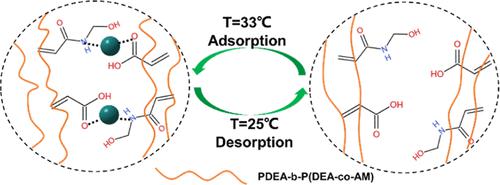当前位置:
X-MOL 学术
›
ACS Appl. Polym. Mater.
›
论文详情
Our official English website, www.x-mol.net, welcomes your feedback! (Note: you will need to create a separate account there.)
Study on the Preparation and Performances of Thermoresponsive Imprinted Polymers for Selective Separation and Purification of Ru(III)
ACS Applied Polymer Materials ( IF 5 ) Pub Date : 2024-03-13 , DOI: 10.1021/acsapm.4c00056 Wan Xu 1, 2 , Bingqian Wang 1, 2 , Yuan Sun 3 , Xiaojian Ou 4 , Yuanjun Sun 4 , Peng Zhang 4 , Zhenbin Chen 1, 2
ACS Applied Polymer Materials ( IF 5 ) Pub Date : 2024-03-13 , DOI: 10.1021/acsapm.4c00056 Wan Xu 1, 2 , Bingqian Wang 1, 2 , Yuan Sun 3 , Xiaojian Ou 4 , Yuanjun Sun 4 , Peng Zhang 4 , Zhenbin Chen 1, 2
Affiliation

|
Ruthenium, one of the platinum group elements, plays a crucial role in industrial development, and it is important to develop a material to separate and purify ruthenium with high efficiency to ensure its supply. Herein, a thermoresponsive Ru(III)-imprinted polymer (Ru(III)-TIIP) was prepared by combining thermoresponsive technology, Pickering emulsion technology, and imprinted technology. The Ru(III)-TIIP could regulate its structure by controlling the external temperature and maintained good adsorption and separation performance. The structure and performances of Ru(III)-TIIP were tested and evaluated by Fourier transform infrared, scanning electron microscopy, energy-dispersive spectrometry, transmission electron microscopy, specific surface area, porosity analysis, zeta potential, X-ray photoelectron spectroscopy, thermogravimetric analysis, and inductively coupled plasma-atomic emission spectrometry. The results showed that the maximum adsorption capacity (Q) of Ru(III)-TIIP was 0.2203 mmol/g under 33 °C. The maximum desorption rate (D %) was 78.1%, which was reached at 25 °C. When Fe(III) was used as the interfering ion, the separation degree (R) of Ru(III)-TIIP was 3.2. Meanwhile, the study of the adsorption process of Ru(III)-TIIP to Ru(III) was more suitable to be expressed by pseudo-first-order kinetics and the Langmuir model. When Ru(III)-TIIP was applied to the platinum group catalyst leach solution, the content of platinum group elements ranged from 53.72 to 82.09% after one adsorption/desorption cycle. In addition, Ru(III)-TIIP had maintained 66.14 and 81.25% of the original capacity for Q and R after 11 adsorption/desorption cycles.
中文翻译:

用于选择性分离纯化Ru(III)的热响应印迹聚合物的制备及性能研究
钌作为铂族元素之一,在工业发展中发挥着至关重要的作用,开发高效分离提纯钌的材料以保证钌的供应具有重要意义。本文将热响应技术、Pickering乳液技术和印迹技术相结合,制备了热响应性Ru(III)印迹聚合物(Ru(III)-TIIP)。 Ru(III)-TIIP可以通过控制外部温度来调节其结构,并保持良好的吸附和分离性能。通过傅里叶变换红外、扫描电镜、能谱、透射电镜、比表面积、孔隙率分析、zeta电位、X射线光电子能谱、热重分析等手段对Ru(III)-TIIP的结构和性能进行了测试和评价分析和电感耦合等离子体原子发射光谱法。结果表明,33℃下Ru(III)-TIIP的最大吸附容量( Q )为0.2203 mmol/g。最大解吸率(D %)为78.1%,在25℃时达到。当使用Fe(III)作为干扰离子时,Ru(III)-TIIP的分离度( R )为3.2。同时,Ru(III)-TIIP对Ru(III)吸附过程的研究更适合用准一级动力学和Langmuir模型来表达。当Ru(III)-TIIP应用于铂族催化剂浸出液时,经过一个吸附/解吸循环后,铂族元素的含量在53.72%至82.09%之间。此外,Ru(III)-TIIP在11次吸附/解吸循环后仍保持了Q和R原始容量的66.14和81.25% 。
更新日期:2024-03-13
中文翻译:

用于选择性分离纯化Ru(III)的热响应印迹聚合物的制备及性能研究
钌作为铂族元素之一,在工业发展中发挥着至关重要的作用,开发高效分离提纯钌的材料以保证钌的供应具有重要意义。本文将热响应技术、Pickering乳液技术和印迹技术相结合,制备了热响应性Ru(III)印迹聚合物(Ru(III)-TIIP)。 Ru(III)-TIIP可以通过控制外部温度来调节其结构,并保持良好的吸附和分离性能。通过傅里叶变换红外、扫描电镜、能谱、透射电镜、比表面积、孔隙率分析、zeta电位、X射线光电子能谱、热重分析等手段对Ru(III)-TIIP的结构和性能进行了测试和评价分析和电感耦合等离子体原子发射光谱法。结果表明,33℃下Ru(III)-TIIP的最大吸附容量( Q )为0.2203 mmol/g。最大解吸率(D %)为78.1%,在25℃时达到。当使用Fe(III)作为干扰离子时,Ru(III)-TIIP的分离度( R )为3.2。同时,Ru(III)-TIIP对Ru(III)吸附过程的研究更适合用准一级动力学和Langmuir模型来表达。当Ru(III)-TIIP应用于铂族催化剂浸出液时,经过一个吸附/解吸循环后,铂族元素的含量在53.72%至82.09%之间。此外,Ru(III)-TIIP在11次吸附/解吸循环后仍保持了Q和R原始容量的66.14和81.25% 。



























 京公网安备 11010802027423号
京公网安备 11010802027423号